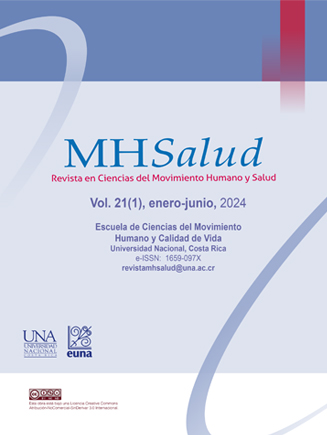

Escuela de Ciencias del Movimiento Humano y Calidad de Vida
Universidad Nacional, Costa Rica
e-ISSN: 1659-097X
Vol. 21(1), enero-junio, 2024
revistamhsalud@una.ac.cr
Licencia: By NC ND 3.0 Internacional

https://doi.org/10.15359/mhs.21-1.16622
Determinants of Physical Performance and Physiological Responses During an Official Cross-Country Marathon of Mountain-Biking (Xcm-Mtb)
Determinantes del rendimiento físico y las respuestas fisiológicas durante una maratón oficial de bicicleta de montaña a través del campo (XCM-MTB)
Determinantes do Desempenho Físico e as Respostas Fisiológicas Durante uma Maratona Oficial de Mountain Bike Cross-Country (Xcm-Mtb)
Guilherme Pereira Saborosa1, Kallil Neves Zuri2, Túlio Junqueira Carneiro3,
Bruno Pereira Melo4, Guilherme de Azambuja Pussieldi5, Francisco de Assis Manoel6,
Sandro Fernandes da Silva7
ABSTRACT:
Introduction: The variables determinants of physical performance in cross-country marathon of mountain biking (XCM-MTB) are still unknown.
Objective: We aimed to verify the training control variables and the physiological responses in an official XCM-MTB race.
Material and methods: 13 athletes (11 men and 2 women; 33.3 ± 12.7 years of age) participated in this study. It was conducted during an official XCM-MTB in Brazil (route of 70 km). The heart rate (HR), altimetry, velocity, temperature, pacing, and power were obtained every 10 km travelled by the STRAVA application. Multiple linear regression analysis was performed to verify whether the variables could predict physical performance.
Results: The athletes maintained constant HR elevation in the corresponding zone 80% HRmax. They also presented a variation in the pacing (F = 35.82; p < 0.001; d = 0.66) and power (F = 7.20; p < 0.001; d = 0.18) showing higher values in the last 10 km. Only pacing can be considered a predictor of the physical performance (β = 0.958; t = 7.30; p < 0.001), specifically the one at 20 km (F = 10.23; p = 0.004; R2 = 0.82).
Conclusion: The study concluded that the analyzed variables are reliable for the performance control in an official XCM-MTB race. HR and power are variables that can be used to prescribe and control training, as they change according to the requirements of the race. Power can also be used as a performance predictor as it is directly influenced by terrain.
Keywords: training, heart rate, physical performance, power.
|
RESUMEN: Introducción: Las variables determinantes del rendimiento físico en una maratón de ciclismo de montaña (XCM-MTB) aún son desconocidas. Objetivo: Nuestro objetivo fue verificar las variables fisiológicas y de control del entrenamiento en una carrera oficial de XCM-MTB. Materiales y métodos: 13 atletas (11 hombres y 2 mujeres; 33,3 ± 12,7 años) participaron en este estudio. La investigación se realizó durante un XCM-MTB oficial en Brasil (recorrido de 70 km). La frecuencia cardíaca (FC), la altimetría, la velocidad, la temperatura, el ritmo y la potencia se obtuvieron cada 10 km recorridos por la aplicación STRAVA. Se realizó un análisis múltiple de regresión linear para verificar si las variables podían predecir el rendimiento físico. Resultados: Hubo una elevación constante de la FC correspondiente al 80 % de la FCmax. El ritmo presentó una variación (F = 35,82; p < 0,001; d = 0,66) y potencia (F = 7,20; p < 0,001; d = 0,18) con valores superiores en los últimos 10 km. Solo el ritmo a los 20 km (F = 10,23; p = 0,004; R2 = 0,82) puede considerarse predictor del rendimiento físico (β = 0,958; t = 7,30; p < 0,001). Conclusión: El estudio concluyó que las variables analizadas son fiables para la prescripción y control del entrenamiento en una carrera oficial de XCM-MTB. La FC y la potencia son variables que se pueden utilizar para prescribir el entrenamiento. La potencia también se puede utilizar para predecir el rendimiento, ya que está directamente influenciada por el terreno. Palabras clave: capacitación, ritmo cardiaco, desempeño físico, energía. |
RESUMO Introdução: As variáveis determinantes do desempenho físico na maratona de mountain bike cross-country (XCM-MTB) ainda são desconhecidas. Objetivo: Nosso objetivo foi verificar as variáveis de controle de treinamento e as respostas fisiológicas em uma corrida oficial de XCM-MTB. Material e métodos: Participaram deste estudo 13 atletas (11 homens e 2 mulheres; 33,3 ± 12,7 anos de idade). O estudo foi realizado durante uma corrida oficial de XCM-MTB no Brasil (percurso de 70 km). A frequência cardíaca (FC), altimetria, velocidade, temperatura, ritmo e potência foram obtidos a cada 10 km percorridos através do aplicativo STRAVA. Foi realizada uma análise de regressão linear múltipla para verificar se as variáveis poderiam prever o desempenho físico. Resultados: Os atletas mantiveram uma elevação constante na FC na zona correspondente a 80% da FC máxima. Apresentaram também variação no ritmo (F = 35,82; p < 0,001; d = 0,66) e na potência (F = 7,20; p < 0,001; d = 0,18), mostrando valores mais altos nos últimos 10 km. Apenas o ritmo pode ser considerado um preditor do desempenho físico (β = 0,958; t = 7,30; p < 0,001), especificamente no ponto dos 20 km (F = 10,23; p = 0,004; R2 = 0,82). Conclusão: O estudo concluiu que as variáveis analisadas são confiáveis para o controle de desempenho em uma corrida oficial de XCM-MTB. A FC e a potência são variáveis que podem ser usadas para prescrever e controlar o treinamento, pois mudam de acordo com as exigências da corrida. A potência também pode ser usada como um preditor de desempenho, pois é diretamente influenciada pelo terreno. Palavras-chave: treinamento, frequência cardíaca, desempenho físico, energia. |
Mountain-biking (MTB) is an off-road cycling modality characterized by competition in rugged and uneven terrain as well as a range obstacles such as jumps, drops, and rocks (Novak et al., 2018). The MTB cross-country marathon (XCM-MTB) is defined by the traveled distance of the race, having a minimum of 60 km and a maximum of 160 km, completed in forest roads, gravel paths, single trails, steep climbs, and technically demanding descents (Schenk et al., 2010). Despite to these characteristics, few studies appear to be available on the physiological characteristics of off-road cycling. In this sense, the prescription of physical training to athlete cyclists has been considered is a challenge to technics and trainers. Therefore, the understanding of the physiological variables during the MTB race can contribute to training planning and for improving the physical performance of the athletes.
The control of the external load of the training involves the organization, quality and quantity of physical work prescribed in the training plan (Impellizzeri et al., 2019). In cycling sports, the velocity, power, pacing, and total time of exercise are widely used variables to control the external load and training prescription (Halson, 2014). Moreover, psychophysiological responses, such as heart rate (HR), maximal oxygen uptake (VO2max), rating perceived exertion (RPE), and lactate blood concentration, are used in the monitoring of internal load and can contribute to determining fatigue and consequently the physical performance of athletes (Impellizzeri & Marcora, 2007).
The HR is an important variable to control of internal load and has been used to estimates the exercise intensity during MTB race (Atkinson et al., 2003). Although, the peak oxygen uptake, the 30s all-out fatigue resistance, and the power variables from a repeated sprint test are able to predict the physical performance in cross-country Olympic MTB (Bejder et al., 2019), the variables determinants of performance in XCM-MTB are still unknown.
Specifically, in an XCM-MTB race, the variability of the terrain found during the race can promote a high variability in the variables predicted by of the physical performance, hindering the prior planning of the race strategy. Although the knowledge of variables involved in the quantification of the internal and external load of training can contribute to developing techniques, assist trainers in providing training prescriptions and training control for athletes, and assist in the planning of the race strategy, these responses during an official XCM-MTB race have not yet been investigated. Therefore, the objective of this study is comparing the physiological variables of training control responses resulting from an official XCM-MTB race, and to verify which of these variables predicts physical performance.
The present study is characterized as quantitative exploratory research and was conducted during an official cross-country marathon MTB race (XCM-MTB) in Brazil (route of 70 km; at the municipality of Lavras to Carrancas-MG). The athletes were informed about the objectives and procedures of the present study and signed the free and informed consent form. The study was approved by the Human Research Ethics Committee (COEP, n°. CAAE: 17544213.4.0000.5148) following the Declaration of Helsinki 1996.
Figure 1 demonstrates the experimental design. Thirteen XCM-MTB athletes (33.3 ± 12.7 years; 71.6 ± 14.5 Kg; 1.7 ± 0,1 m; 24.4 ± 6.1 Kg/m2) of both sexes (11 men and 2 women) with at least two years of experience in MTB racing participated in this study. The inclusion criteria were athletes who followed a training plan, with frequent participation in competitions of MTB and who used a highly reliable device to measure the following variables: energy expenditure (EE), heart rate (HR), altimetry, velocity, temperature, and power. HR was continuously monitored throughout the test using a telemetric HR monitor (Garmin, Switzerland). Athletes in which the device could not provide information on the analyzed variables and those who were unable to complete the race were excluded from the present study. The variables involved in the quantification of internal and external load training, were obtained through STRAVA (San Francisco, CA 94103, USA) and analyzed every 10 km during the official XCM-MTB race. After the description and comparison of the variables during the XCM-MTB race, the results of the winner were compared with the other competitors to verify when and which variables are determinants of physical performance.
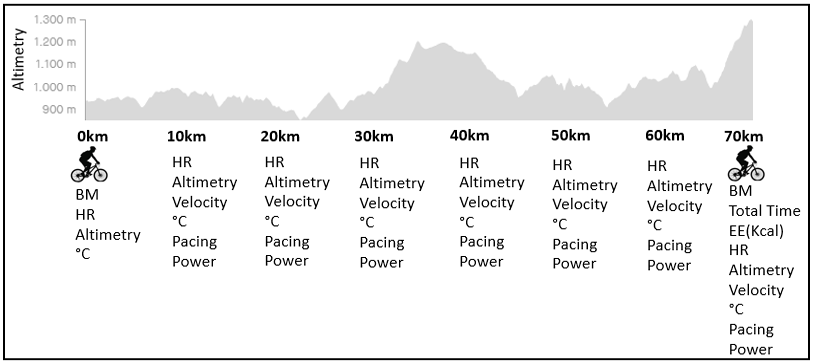
BM: Body Mass; HR: Heart Rate; Temperature (°C): Degree Celsius; EE: Energy Expenditure.
Data collection
The body mass of the athletes was measured using a digital scale (G-tech, Glass-10; CARMY ELETRONIC LTD, Zhongshan) before and immediately after the XCM-MTB event. HR, altimetry, speed, temperature, stimulation and power were obtained for every 10 km travelled using the STRAVA application (San Francisco, CA 94103, USA). STRAVA allows the monitoring of cycling and running exercises using a global positioning system (GPS). It is also possible to transfer GPS data from a watch to STRAVA, even with the limitation of not providing the same GPS watch to all the participants. Commonly marketed GPS running watches used in a study by Gilgen-Ammann et al. (2020), showed moderate to good accuracy in relation to the distances recorded with a measurement error ranging from 3.2 to 6.1% in urban areas, forests and athletic tracks. Therefore, after the trip ends, the calories burned, maximum speed, average speed, HR and power data are sent to the website or application (West, 2015). To obtain HR data, a compatible monitor is needed, while for power, a potentiometer built into the bike or Strava estimates power using information on weight (athlete and bike), speed and elevation variation to monitor the energy placed on the pedals (time the athlete pedals) or in moments of deceleration, indicating a value of 0 (West, 2015). The results were extracted and analyzed every 10 km during the official XCM-MTB race. HRmax was the age-predicted heart rate (Tanaka et al., 2001). The progress was analyzed by the average of the time needed to cover the 10km. For the prediction of the time, the following equation was used: Total time (min) = 48.56 + 5.336 x (pacing at 20 km). The EE was also obtained by STRAVA and represented the total caloric expenditure of the MTB run.
Statistical Analysis
Shapiro-Wilk and Levene’s tests were used to assess the normality and homoscedasticity of the data, respectively. The results are expressed as the mean values ± mean standard deviations. The power to detect a given effect size was an α error of 0.43. For the effect size, Cohen (1988) and (Lakens, 2013) was calculated for pairwise comparisons, with values > 0.8, 0.5-0.8, 0.2-0.5 and < 0.2 considered large, moderate, small and trivial, respectively.
The body mass before and after the XCM-MTB race was compared by test T of Tukey. The comparison of the variables analyzed (HR, altimetry, velocity, temperature, pacing and power) during the XCM-MTB race was analyzed using one-way ANOVA with repeated measures on time. When the comparison of variables over time was added to the comparison between the groups (winner x other competitors), two-way ANOVA with repeated measures on time were used. For all aforementioned ANOVAs, when significant main effects were found, Tukey post hoc test was further performed to examine pairwise differences. Pearson’s correlations were used to verify the relationship between the variables analyzed and physical performance (total time to complete the XCM-MTB race). Multiple linear regression analysis was performed to verify whether the studied variables could predict an athlete’s physical performance. All statistical analyses were performed using SPSS software (IBM SPSS® software, version 20.0; Armonk, New York, 10504, USA), adopting a significance level of α = 5% (p < 0.05).
The athletes completed the XCM-MTB race in 227.20 ± 16.26 min and presented an energy expenditure of 2546.15 ± 681.32 kcal, without a significant difference in body mass compared to baseline (71.6 ± 14.5 vs. 69.05 ± 14.25 kg; p = 0.769). The heart rate, altimetry, velocity, temperature, pacing, and power during the MTB race are demonstrated in Figure 2. When compared to baseline, the heart rate increased significantly in the 10 km, 20 km, 30 km and 60 km (F = 4.65; p < 0.001; d = 0.11; Figure 2a). The altimetry varied significantly during the XCM-MTB race presenting a peak elevation at 30 km (F = 18.10; p < 0.001; d = 0.61; Figure 2b) and the velocity increased significantly compared to that at 30 km (F = 16.66; p < 0.001; d = 0.56; Figure 2c). The temperature increased during the XCM-MTB race (F = 49.65; p < 0.001; d = 0.63: Figure 2d), reaching 21.62 ± 1.56°C at the end of the race. The athletes also presented a variation in pacing (F = 35.82; p < 0.001; d = 0.66; Figure 2e) and power (F = 7.20; p < 0.001; d = 0.18; Figure 2f).
Figure 2
Heart rate, altimetry, velocity, temperature and, pacing during mountain biking performance.
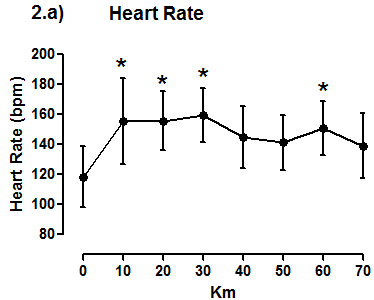
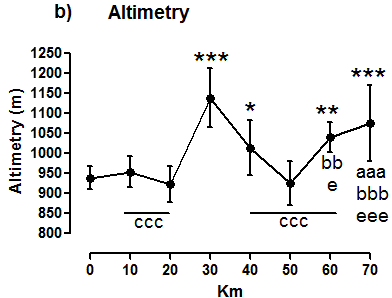
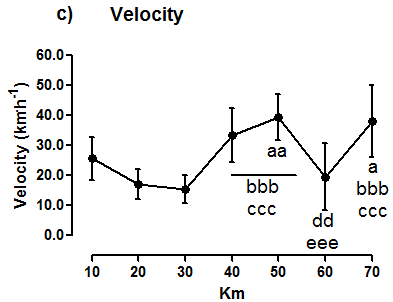
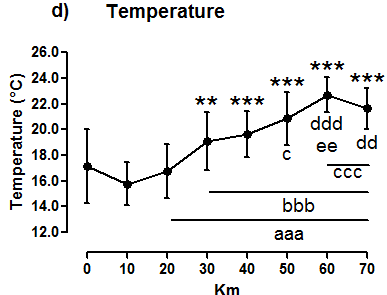

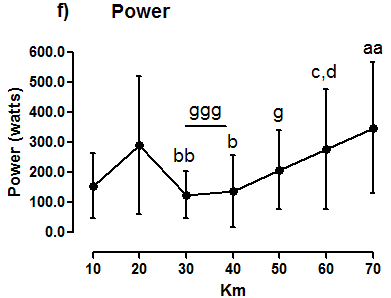
Data are expressed at mean and standard deviation.
* Significant difference from baseline (0 km): * p < 0.05; ** p < 0.01; *** p < 0.001;
a Significant difference from baseline (10 km): a p < 0.05; aa p < 0.01; aaa p < 0.001;
b Significant difference from baseline (20 km): bb p < 0.01; bbb p < 0.001;
c Significant difference from baseline (30 km): c p < 0.05; ccc p < 0.001;
d Significant difference from baseline (40 km): dd p < 0.01; ddd p < 0.001;
e Significant difference from baseline (50 km): e p < 0.05; ee p < 0.01; eee p < 0.001;
g Significant difference from baseline (70 km): ggg p < 0.001.
The correlations between heart rate, velocity, pacing, and power and the total time to complete the XCM-MTB race are presented in Figure 3. Only pacing demonstrated a significant correlation with the total time to complete the XCM-MTB race (Figure 3c). The analysis resulted in a significant model (F = 16.14; p = 0.001; R2 = 0.891). Only pacing could be considered a predictor of the total time (β = 0.958; t = 7.30; p <0.001). Therefore, we performed an analysis of the pacing obtained every 10 km in predicting physical performance. The analysis resulted in a significant model (F = 10.23; p = 0.004; R2 = 0.82), and pacing at 20 km could be considered a predictor of the total time.
Figure 3
Correlation between heart rate, velocity, pacing, and power with the total time to complete the competition.
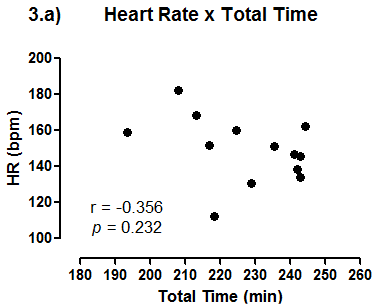
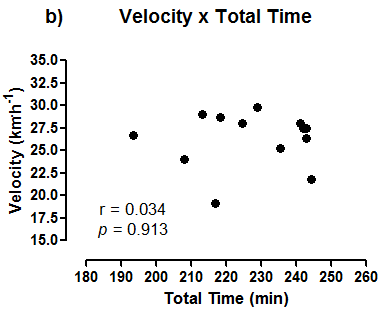
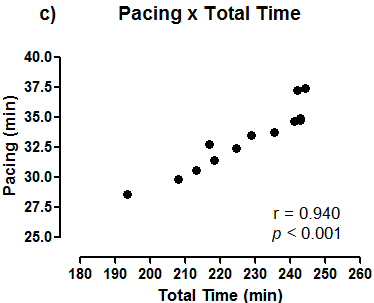
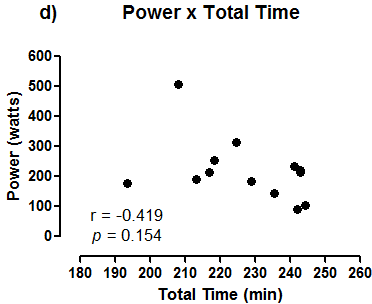
The comparison of the heart rate, velocity, pacing, and power between the winner and other competitors are presented in Figure 4. The HR of the winner was higher during the XCM-MTB race (Figure 4a). The winner also presented higher velocities at 10 km, 20 km, and 50 km (Figure 4b) and lower pacings at 20 km, 30 km, 60 km and 70 km (Figure 4c). Moreover, the winner presented higher power during the XCM-MTB (Figure 4d).
Figure 4
Comparison of heart rate, velocity, pacing and power betweenn the winner and other competitors.

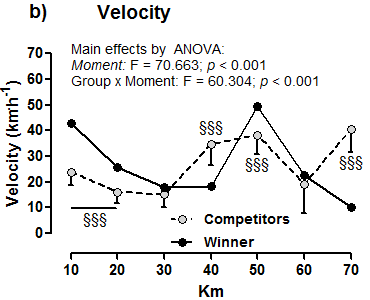
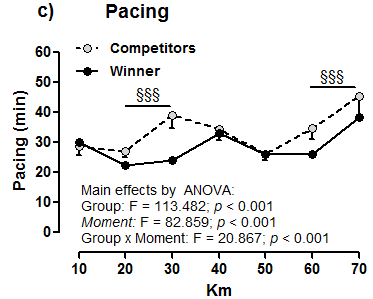

Data are expressed as the mean and standard deviation.
Figure 3a-d: Only the main effects by ANOVA that were significant are displayed on the graphs;
Post hoc analyses for a group effect: § p < 0.05; §§§ p < 0.001 for the winner vs. other competitors.
The present study described and compared the training control variables and the physiological responses during an official XCM-MTB race. The results demonstrated that athletes are able to maintain an elevated HR for a long period of time, maintaining a constant HRmax of 80% in the corresponding zone throughout the race. The high variability found in the variables of training control demonstrated that velocity, power, and pacing are associated with terrain characteristics and altimetry variation during an XCM-MTB race. Moreover, the present study demonstrated that pacing was able to predict the physical performance of athletes; specifically the pacing at 20 km was able to predict 82% of the total time to complete the XCM-MTB race.
Due to the high aerobic demands of the competition, mountain biker athletes have high cardiovascular capacities and are able to maintain elevated velocity and power throughout the event (Granier et al., 2018). Studies (Gregory et al., 2007; Impellizzeri & Marcora, 2007) show that mountain biking athletes showed significant correlations between running time and maximal and submaximal aerobic fitness, (Gregory et al., 2007) cross-country running time correlates with physiological responses such as power in relation to body mass (r = 0.93) and relative Vo2peak (r = 0,80). Moreover, athletes of cyclocross showed a sustained elevated HR and high lactate concentration during the cyclocross race (Carmichael et al., 2017). In the present study, we demonstrated that XCM-MTB athletes also showed a significant increase in HR in the first kilometers and maintained a constant elevation in the corresponding HRmax zone of 80% throughout the race. Similar results for HR were observed in the study by Bertuzzi et al. (2006), when analyzing the behavior of the HR during an endurance test (performance of a 10 km race). The authors observed a significant increase after 12 minutes and it remained high until the end of the performance. Cross-country mountain biking races present variations in intensity, with a high demand on cardiovascular conditioning and high power (Arriel et al., 2022). In addition to the metabolic demand required by exercise, this high HR value may also be associated with extrinsic factors such as environmental temperature and the hydration status of individuals (Achten & Jeukendrup, 2003; Bertuzzi et al., 2006). HR is an important variable to control internal training load and intensity in endurance sports (Mujika, 2017). Therefore, understanding the values and HR intensity zones during an official MTB race can be useful for developing techiniques and for trainers to provied better training prescriptions and training control for athletes.
Velocity and power have been extensively used to determine external load training; however, in cycling these variables can be influenced by the characteristics of the terrain. In a cross-country race, athletes are required to ascend hills more often and at high speeds, thus explaining why power output plays an important role (Engelbrecht & Terblanche, 2018). Specifically, in an MTB race, the power increases on steep terrain sections, whereas in the subsequent terrain, the power output is reduced, and at these moments, the power is inversely associated with velocity (Gregory et al., 2007). In the present study, the mean power peak ranged between 136 and 348 watts, which could be explained by phases where maximal and supra-maximal efforts were necessary, including steep climbing, and/or when sprinting to pass slower riders (Impellizzeri et al., 2005).
In downhill moments, the required effort and power were reduced, whereas the HR remained elevated, presumably because of the effect of isometric muscle contractions, which could impair recovery after periods of high-power output (Gregory et al., 2007). In the present study, we also identified that the HR remained elevated independently of the variation in altimetry. The total elevation gain is a major contributor to increasing overall loads of exercise (Sanders & Heijboer, 2019) and therefore is another important variable for training control.
Although the VO2max, 60 s maximal mean power output, peak grip strength, and decision-making ability are likely to be beneficial in the performance of mountain bikers during 4 h event (Novak et al., 2018), to the best of our knowledge, this is the first study to demonstrate the determinant variables of physical performance in an XCM-MTB race. The multivariate linear analysis demonstrated that only pacing can be considered a predictor of physical performance in an XCM-MTB race; specifically, pacing at 20 km can predict 82% of the total time to complete an MTB race. In the present study, the winner of the XCM-MTB showed lower pacing throughout the race when compared to the other competitors. Economy of movement during the run, presents a moderate inverse correlation (r = -0.53) with the final time race in Olympic Cross-Country mountain biking athletes, showing a low developed power (Inoue et al., 2022). Pacing is a variable associated with the strategy of the race with the objective of avoiding premature fatigue (De Koning et al., 2011). Specifically, in XCM-MTB, a pacing strategy with a higher speed while climbing and a higher speed while descending is typical of faster performances (Moss et al., 2019). Therefore, pacing control is of great importance for training control and can be considered a variable determinant of physical performance in an XCM-MTB race.
In addition to the presented results, other variables may also be associated with fatigue and physical performance in MTB athletes, including psychophysiological responses, race strategy, anaerobic power, age, sex, and race experience (Inoue et al., 2012; Moss et al., 2019). One of the limitations of the study was not knowing the data from a progressive test, and thus determining which intensity domains were more determinant in the test and thus relating these domains to the variables studied. Therefore, future research should emphasize that analysis of the other variables associated with physical performance and training programs should be designed to specifically improve both aerobic and anaerobic systems, considering the internal and external load control through the variables studied.
The present study concluded that the analyzed variables are reliable for training control in an official XCM - MTB race. The HR and power are variables that can be used to prescribe training, as they change according to the requirements of the race. Power can also be used as a performance predictor as it is directly influenced by terrain. For the prescription and control of mountain biking training, it is important to identify how heart rate and power respond to the demands of the race, promoting adaptations and changes in a training periodization.
Achten, J. & Jeukendrup, A. E. (2003). Maximal Fat Oxidation During Exercise in Trained Men. International Journal of Sports Medicine, 24(8), 603-608. https://doi.org/10.1055/s-2003-43265
Arriel, R. A., Souza, H. L. R., Sasaki, J. E. & Marocolo, M. (2022). Current Perspectives of Cross-Country Mountain Biking: Physiological and Mechanical Aspects, Evolution of Bikes, Accidents and Injuries. International Journal of Environmental Research and Public Health, 19(19), 12552. https://doi.org/10.3390/ijerph191912552
Atkinson, G., Davison, R., Jeukendrup, A. & Passfield, L. (2003). Science and cycling: Current knowledge and future directions for research. Journal of Sports Sciences, 21(9), 767-787. https://doi.org/10.1080/0264041031000102097
Bejder, J., Bonne, T. C., Nyberg, M., Sjøberg, K. A. & Nordsborg, N. B. (2019). Physiological determinants of elite mountain bike cross-country Olympic performance. Journal of Sports Sciences, 37(10), 1154-1161. https://doi.org/10.1080/02640414.2018.1546546
Bertuzzi, R. C. D. M., Nakamura, F. Y., Rossi, L. C., Kiss, M. A. P. D. & Franchini, E. (2006). Independência temporal das respostas do esforço percebido e da freqüência cardíaca em relação à velocidade de corrida na simulação de uma prova de 10km. Revista Brasileira de Medicina Do Esporte, 12(4), 179-183. https://doi.org/10.1590/S1517-86922006000400003
Cohen, J. (1988). Statistical Power Analysis for the Behavioral Sciences. Academic Press.
Carmichael, R. D., Heikkinen, D. J., Mullin, E. M. & McCall, N. R. (2017). Physiological Response to Cyclocross Racing. Sports and Exercise Medicine - Open Journal, 3(3), 74-80. https://doi.org/10.17140/semoj-3-152
De Koning, J. J., Foster, C., Bakkum, A., Kloppenburg, S., Thiel, C., Joseph, T., Cohen, J. & Porcari, J. P. (2011). Regulation of pacing strategy during athletic competition. PLoS ONE, 6(1). https://doi.org/10.1371/journal.pone.0015863
Engelbrecht, L. & Terblanche, E. (2018). Physiological performance predictors in mountain bike multi-stage races. Journal of Sports Medicine and Physical Fitness, 58(7-8), 951-956. https://doi.org/10.23736/S0022-4707.17.07139-0
Gilgen-Ammann, R., Schweizer, T. & Wyss, T. (2020). Accuracy of Distance Recordings in Eight Positioning-Enabled Sport Watches: Instrument Validation Study. JMIR MHealth and UHealth, 8(6), e17118. https://doi.org/10.2196/17118
Granier, C., Abbiss, C. R., Aubry, A., Vauchez, Y., Dorel, S., Hausswirth, C. & Le Meur, Y. (2018). Power Output and Pacing During International Cross-Country Mountain Bike Cycling. International Journal of Sports Physiology and Performance, 13(9), 1243-1249. https://doi.org/10.1123/ijspp.2017-0516
Gregory, J., Johns, D. P. & Walls, J. T. (2007). Relative vs Absolute Physiological Measures as Predictors of Mountain Bike Cross-Country Race Performance. Journal of Strength and Conditioning Research, 21(1), 17-22. https://doi.org/10.1519/00124278-200702000-00004
Halson, S. L. (2014). Monitoring Training Load to Understand Fatigue in Athletes. In Sports Medicine (vol. 44, pp. 139-147). Springer International Publishing. https://doi.org/10.1007/s40279-014-0253-z
Impellizzeri, F. M., Marcora, S. M., Rampinini, E., Mognoni, P. & Sassi, A. (2005). Correlations between physiological variables and performance in high level cross country off road cyclists. British Journal of Sports Medicine, 39(10), 747-751. https://doi.org/10.1136/bjsm.2004.017236
Impellizzeri, F. M. & Marcora, S. M. (2007). The physiology of mountain biking. In Sports Medicine (vol. 37, Issue 1, pp. 59-71). Adis International Ltd. https://doi.org/10.2165/00007256-200737010-00005
Impellizzeri, F. M., Marcora, S. M. & Coutts, A. J. (2019). Internal and external training load: 15 years on. International Journal of Sports Physiology and Performance, 14(2), 270-273. https://doi.org/10.1123/ijspp.2018-0935
Inoue, A., Lattari, E., do Carmo, E. C., Rodrigues, G. M., de Oliveira, B. R. R. & Santos, T. M. (2022). Correlation between economy/efficiency and mountain biking cross-country race performance. European Journal of Sport Science, 22(11), 1641-1648. https://doi.org/10.1080/17461391.2021.1968504
Inoue, A., Sáfilho, A. S., Mello, F. C. M. & Santos, T. M. (2012). Relationship between anaerobic cycling tests and mountain bike cross-country performance. Journal of Strength and Conditioning Research, 26(6), 1589-1593. https://doi.org/10.1519/JSC.0b013e318234eb89
Lakens, D. (2013). Calculating and reporting effect sizes to facilitate cumulative science: A practical primer for t-tests and ANOVAs. Frontiers in Psychology, 4(NOV), 1-12. https://doi.org/10.3389/fpsyg.2013.00863
Moss, S. L., Francis, B., Calogiuri, G. & Highton, J. (2019). Pacing during a cross-country mountain bike mass-participation event according to race performance, experience, age and sex. European Journal of Sport Science, 19(6), 793-801. https://doi.org/10.1080/17461391.2018.1552722
Mujika, I. (2017). Quantification of training and competition loads in endurance sports: Methods and applications. In International Journal of Sports Physiology and Performance (vol. 12, pp. 9-17). Human Kinetics Publishers Inc. https://doi.org/10.1123/ijspp.2016-0403
Novak, A. R., Bennett, K. J. M., Fransen, J. & Dascombe, B. J. (2018). Predictors of performance in a 4-h mountain-bike race. Journal of Sports Sciences, 36(4), 462-468. https://doi.org/10.1080/02640414.2017.1313999
Sanders, D. & Heijboer, M. (2019). Physical demands and power profile of different stage types within a cycling grand tour. European Journal of Sport Science, 19(6), 736-744. https://doi.org/10.1080/17461391.2018.1554706
Schenk, K., Gatterer, H., Ferrari, M., Ferrari, P., Cascio, V. Lo & Burtscher, M. (2010). Bike transalp 2008: Liquid intake and its effect on the body’s fluid homeostasis in the course of a multistage, cross-country, MTB marathon race in the central alps. Clinical Journal of Sport Medicine, 20(1), 47-52. https://doi.org/10.1097/JSM.0b013e3181c9673f
Tanaka, H., Monahan, K. D. & Seals, D. R. (2001). Age-predicted maximal heart rate revisited. Journal of the American College of Cardiology, 37(1), 153-156. https://doi.org/10.1016/S0735-1097(00)01054-8
West, L. R. (2015). Strava: challenge yourself to greater heights in physical activity/cycling and running. British Journal of Sports Medicine, 49(15), 1024-1024. https://doi.org/10.1136/bjsports-2015-094899
ACKNOWLEDGMENTS
The authors of this study would like to thank all the volunteers and authors who participated in the development of the research.
There was no financial aid for the study.
Guilherme Pereira Saborosa contributed to the conception (lead) and design of the work, to the acquisition, analysis, and interpretation of data for the work; AND drafting the work, AND final approval of the version to be published. Kallil Neves Zuri contributed to the conception and design of the work, to the acquisition, analysis, and interpretation of data for the work; AND drafting the work, AND final approval of the version to be published. Túlio Junqueira Carneiro contributed to the conception and design of the work, to the acquisition, analysis, and interpretation of data for the work; AND drafting the work, AND final approval of the version to be published. Bruno Pereira Melo contributed to the conception and design of the work, to the acquisition, analysis, and interpretation of data for the work; AND drafting the work, AND final approval of the version to be published. Guilherme de Azambuja Pussieldi contributed to the conception and design of the work, to the acquisition, analysis, and interpretation of data for the work; AND drafting the work, AND final approval of the version to be published. Francisco de Assis Manoel contributed to the conception and design of the work, to the acquisition, analysis, and interpretation of data for the work; AND drafting the work, AND final approval of the version to be published. Sandro Fernandes da Silva contributed to the conception and design of the work, to the acquisition, analysis, and interpretation of data for the work; AND drafting the work, AND final approval of the version to be published.
The authors agreement to be accountable for all aspects of the work in ensuring that questions related to the accuracy or integrity of any part of the work are appropriately investigated and resolved.
DECLARATION OF INTERESTS STATEMENT
The authors declare no conflicts of interest.
Recibido: 13-4-2022 - Aceptado: 12-4-2023
1
 0000-0002-4822-4279 The Federal University of Lavras, Department of Physical Education, Group of Studies and Research on Neuromuscular Responses (GEPREN), University Campus, Post office box: 3037; ZIP code 37200-000, Lavras, Minas Gerais, Brazil. Email: guisaborosa08@gmail.com
0000-0002-4822-4279 The Federal University of Lavras, Department of Physical Education, Group of Studies and Research on Neuromuscular Responses (GEPREN), University Campus, Post office box: 3037; ZIP code 37200-000, Lavras, Minas Gerais, Brazil. Email: guisaborosa08@gmail.com2
 0000-0002-9738-2062 The Federal University of Lavras, Department of Physical Education, Group of Studies and Research on Neuromuscular Responses (GEPREN), University Campus, Post office box: 3037; ZIP code 37200-000, Lavras, Minas Gerais, Brazil. Email: kallilzena@gmail.com
0000-0002-9738-2062 The Federal University of Lavras, Department of Physical Education, Group of Studies and Research on Neuromuscular Responses (GEPREN), University Campus, Post office box: 3037; ZIP code 37200-000, Lavras, Minas Gerais, Brazil. Email: kallilzena@gmail.com3
 0000-0003-1346-1095 The Federal University of Lavras, Department of Physical Education, Group of Studies and Research on Neuromuscular Responses (GEPREN), University Campus, Post office box: 3037; ZIP code 37200-000, Lavras, Minas Gerais, Brazil. Email: tuliocarmocity@gmail.com
0000-0003-1346-1095 The Federal University of Lavras, Department of Physical Education, Group of Studies and Research on Neuromuscular Responses (GEPREN), University Campus, Post office box: 3037; ZIP code 37200-000, Lavras, Minas Gerais, Brazil. Email: tuliocarmocity@gmail.com4
 0000-0001-9201-8125 The Federal University of Minas Gerais, Department of Physical Education, Exercise Physiology Laboratory, Av. Pres. Antônio Carlos, 6627 Campus-Pampulha, Belo Horizonte, Brazil. Email: brunomelo-89@hotmail.com
0000-0001-9201-8125 The Federal University of Minas Gerais, Department of Physical Education, Exercise Physiology Laboratory, Av. Pres. Antônio Carlos, 6627 Campus-Pampulha, Belo Horizonte, Brazil. Email: brunomelo-89@hotmail.com 5
 0000-0002-0275-5226 The Federal University of Lavras, Department of Physical Education, Group of Studies and Research on Neuromuscular Responses (GEPREN), University Campus, Post office box: 3037; ZIP code 37200-000, Lavras, Minas Gerais, Brazil.
0000-0002-0275-5226 The Federal University of Lavras, Department of Physical Education, Group of Studies and Research on Neuromuscular Responses (GEPREN), University Campus, Post office box: 3037; ZIP code 37200-000, Lavras, Minas Gerais, Brazil.6
 0000-0003-1841-5637 The Federal University of Lavras, Department of Physical Education, Group of Studies and Research on Neuromuscular Responses (GEPREN), University Campus, Post office box: 3037; ZIP code 37200-000, Lavras, Minas Gerais, Brazil. Email: franciscomanoel@ufla.br
0000-0003-1841-5637 The Federal University of Lavras, Department of Physical Education, Group of Studies and Research on Neuromuscular Responses (GEPREN), University Campus, Post office box: 3037; ZIP code 37200-000, Lavras, Minas Gerais, Brazil. Email: franciscomanoel@ufla.br7
 0000-0003-0516-6408 The Federal University of Lavras, Department of Physical Education, Group of Studies and Research on Neuromuscular Responses (GEPREN), University Campus, Post office box: 3037; ZIP code 37200-000, Lavras, Minas Gerais, Brazil. Email: sandrofs@ufla.br
0000-0003-0516-6408 The Federal University of Lavras, Department of Physical Education, Group of Studies and Research on Neuromuscular Responses (GEPREN), University Campus, Post office box: 3037; ZIP code 37200-000, Lavras, Minas Gerais, Brazil. Email: sandrofs@ufla.br
Escuela de Ciencias del Movimiento Humano y Calidad de Vida
Benjamín Nuñez Campus, Universidad Nacional, Lagunilla, Heredia, Costa Rica
PO Box: 86-3000. Heredia, Costa Rica
Phone: (506) 2562-6980
E-mail revistamhsalud@una.ac.cr
